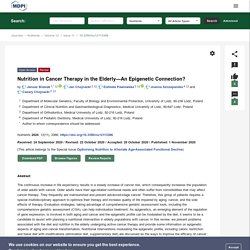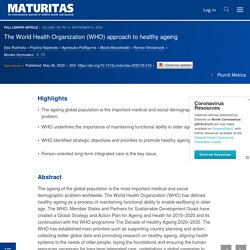

Diabetes, CVD & Obesity Guidelines. Dementia Guidelines. Fraility, Dysphagia & Sarcopenia Guidelines. Fractures Guidelines. Nutrition in Cancer Therapy in the Elderly—An Epigenetic Connection? 1.

Introduction Aging of societies implies an increasing number of cancer diagnoses in the elderly [1]. As older adults have substantially different nutritional needs than their younger counterparts, the question is whether such differences will result in a different response to cancer therapy in the categories of both the efficacy in the target tissue and unwanted side effects. Any kind of cancer therapy is a serious challenge and burden for the patient, so it should be adjusted to the nutritional status of the patient and vice versa. Nutritional studies among older adults with cancer are considered a major area of interest in geriatric oncology, as most studies on diet and nutrition in cancer have been conducted in younger adults [2].
In general, the care of older adults with cancer is complex due to competing comorbidities, multiple drugs usage, deficit in cognitive functions, and other features complicating the care. 2. Figure 1. Figure 2. 3. 4. 5. Figure 3. Figure 4. 6. 7. 1. 2. From lifespan to healthspan: the role of nutrition in healthy ageing. The public health significance of improving healthspan (v. lifespan) For more than 150 years, life expectancy has been increasing due, initially, to reductions in childhood mortality and, since the middle of the 20th century, to declining late-life mortality(Reference Kirkwood6).

This has led to accelerating growth in the numbers of centenarians in countries with the greatest life expectancy(Reference Vaupel7). But not for everyone, everywhere. Inequalities abound; for example, life expectancy in Europe varies markedly between Eastern European and Western European countries. Besides geography, gender has a great impact on humans’ life expectancy. In Eastern European countries, 37 % of male deaths related to non-communicable diseases (NCDs) occur before the age of 60, often caused by cancer(9), exacerbated by men's lower usage of prevention and health care services and the tendency to seek medical help later as compared to women(10). A study by Springmann et al. Fig. 1. Fig. 2. Fig. 3. Fluid Intake Recommendation Considering the Physiological Adaptations of Adults Over 65 Years: A Critical Review. 1.

Introduction Water is the main component of the human body, accounting for over 50% of total body mass [1]. The actual percentage varies, depending on the water losses that take place over the course of the day through respiration, sweat, urine, and feces. A minimum daily fluid intake is, therefore, required to compensate for these losses [2]. Water homeostasis is the key to maintaining a balance between liquid inputs and outputs. The World Health Organization (WHO) approach to healthy ageing - Maturitas. Highlights •The ageing global population is the important medical and social demographic problem.

•WHO underlines the importance of maintaining functional ability in older age. •WHO identified strategic objectives and priorities to promote healthy ageing. •Person-oriented long-term integrated care is the key issue. Abstract. Economic Impact of Implementing Malnutrition Screening and Nutritional Management in Older Adults in General Practice. This service evaluation demonstrates practically the positive impact of following the Malnutrition Pathway for patients at risk of malnutrition in primary care, over a short period of time.

It highlights the importance of screening and appropriate management which includes using oral nutrition support and reviewing patients against goals. It highlights the greatest impact for both the patient and healthcare economy is in the management of those at HR, who received DA and high protein ready to drink ONS. Overall patients at HR achieved the greatest reductions in hospital admissions, length of stay, GP contacts, and antibiotic prescriptions, all of which were significantly reduced. Alongside the economic benefits, malnutrition risk was reduced and patients reported being highly satisfied with the interventions (DA and ONS), and had excellent compliance to ONS. Potentially modifiable determinants of malnutrition in older adults: A systematic review - Clinical Nutrition. Nutrition and longevity – From mechanisms to uncertainties: Critical Reviews in Food Science and Nutrition: Vol 0, No 0.
Position of the Academy of Nutrition and Dietetics and the Society for Nutrition Education and Behavior: Food and Nutrition Programs for Community-Residing Older Adults - Journal of the Academy of Nutrition and Dietetics. Position of the Academy of Nutrition and Dietetics: Individualized Nutrition Approaches for Older Adults: Long-Term Care, Post-Acute Care, and Other Settings. Nutritional management of older adults with gastrointestinal cancers: An International Society of Geriatric Oncology (SIOG) review paper - Journal of Geriatric Oncology. Weight Loss Strategies in the Elderly: A Clinical Conundrum - Coker - 2017 - Obesity.
Long-Term Nutrition A Clinician’s Guide to Successful Long-Term Enteral Access in Adults. Oral health for adults in care homes. This guideline covers oral health, including dental health and daily mouth care, for adults in care homes.

The aim is to maintain and improve their oral health and ensure timely access to dental treatment. Your responsibility The recommendations in this guideline represent the view of NICE, arrived at after careful consideration of the evidence available. When exercising their judgement, professionals are expected to take this guideline fully into account, alongside the individual needs, preferences and values of their patients or service users.
Nutritional status assessment in geriatrics.